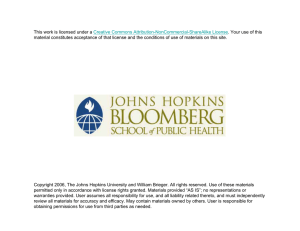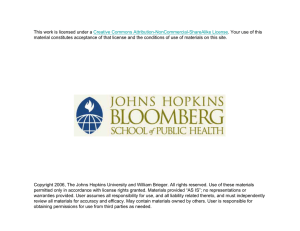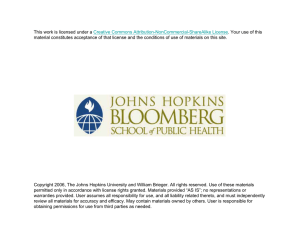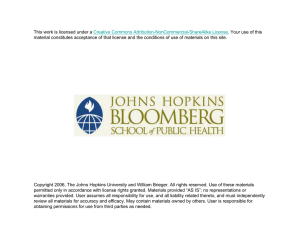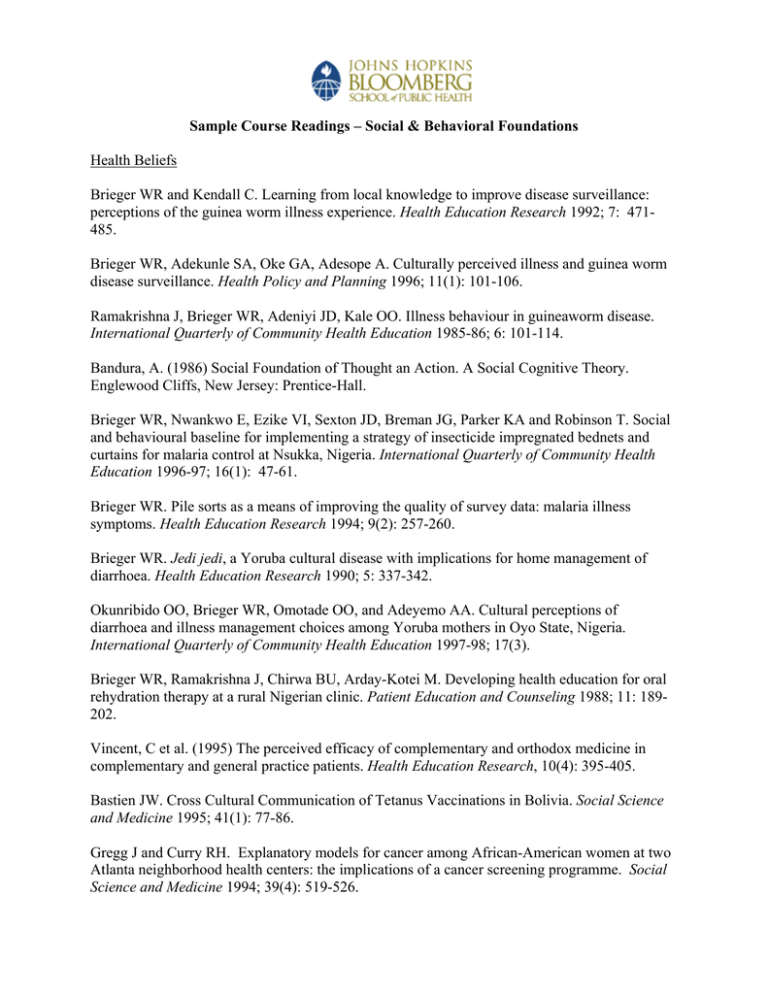
Sample Course Readings – Social & Behavioral Foundations
Health Beliefs
Brieger WR and Kendall C. Learning from local knowledge to improve disease surveillance:
perceptions of the guinea worm illness experience. Health Education Research 1992; 7: 471485.
Brieger WR, Adekunle SA, Oke GA, Adesope A. Culturally perceived illness and guinea worm
disease surveillance. Health Policy and Planning 1996; 11(1): 101-106.
Ramakrishna J, Brieger WR, Adeniyi JD, Kale OO. Illness behaviour in guineaworm disease.
International Quarterly of Community Health Education 1985-86; 6: 101-114.
Bandura, A. (1986) Social Foundation of Thought an Action. A Social Cognitive Theory.
Englewood Cliffs, New Jersey: Prentice-Hall.
Brieger WR, Nwankwo E, Ezike VI, Sexton JD, Breman JG, Parker KA and Robinson T. Social
and behavioural baseline for implementing a strategy of insecticide impregnated bednets and
curtains for malaria control at Nsukka, Nigeria. International Quarterly of Community Health
Education 1996-97; 16(1): 47-61.
Brieger WR. Pile sorts as a means of improving the quality of survey data: malaria illness
symptoms. Health Education Research 1994; 9(2): 257-260.
Brieger WR. Jedi jedi, a Yoruba cultural disease with implications for home management of
diarrhoea. Health Education Research 1990; 5: 337-342.
Okunribido OO, Brieger WR, Omotade OO, and Adeyemo AA. Cultural perceptions of
diarrhoea and illness management choices among Yoruba mothers in Oyo State, Nigeria.
International Quarterly of Community Health Education 1997-98; 17(3).
Brieger WR, Ramakrishna J, Chirwa BU, Arday-Kotei M. Developing health education for oral
rehydration therapy at a rural Nigerian clinic. Patient Education and Counseling 1988; 11: 189202.
Vincent, C et al. (1995) The perceived efficacy of complementary and orthodox medicine in
complementary and general practice patients. Health Education Research, 10(4): 395-405.
Bastien JW. Cross Cultural Communication of Tetanus Vaccinations in Bolivia. Social Science
and Medicine 1995; 41(1): 77-86.
Gregg J and Curry RH. Explanatory models for cancer among African-American women at two
Atlanta neighborhood health centers: the implications of a cancer screening programme. Social
Science and Medicine 1994; 39(4): 519-526.
Social Networks
Barnes ST. Voluntary associations in a metropolis: the case of Lagos, Nigeria. African Studies
Review 1975; 18(2): 75-87.
Mittelmark M.B. Social ties and health promotion Health Education Research 1999; 14(4): 447.
Cassel JC (1976) the contribution of the social environment to host resistance. American Journal
of Epidemiology, 104: 107-124.
Cohen S, Kaplan JR, Manuk SB (1994) Social support and coronary heart disease. In Shumaker
SA and Czajkowski SM (eds.) Social Support and Cardiovascular Diseases, Plenum Press, New
York, pp. 86-118.
Rook KS (1990) Stressful aspects of older adults’ social relationships: an overview of current
theory and research. In Stephens MAP, et al. (eds.) Stress and Coping in Later Life Families,
Hemisphere, Washington, pp. 173-192.
Wills TA (1985) Supportive functions of interpersonal relationships. In Cohen S and Syme SL
(eds.) Confronting Relationship Challenges, Sage, Thousand Oaks, CA, pp. 43-72.
McColl MA, Lei H and Skinner H. Structural relationships between social support and coping.
Social Science and Medicine 1995; 41(3): 395-407.
Shye D, Mullooly JP, Freeborn DK and Pope CR. Gender differences in the relationship
between social network support and mortality: a longitudinal study of an elderly cohort. Social
Science and Medicine 1995; 41(7): 935-947.
TW Valente, SC Watkins, MN Jato, A van der Straten and LM Tsitsol Social network
associations with contraceptive use among Cameroonian women in voluntary associations.
Social Science and Medicine 1997; 45(5): 677-687.
John Scott. Social Network Analysis. Sage Publications (London, Newbury Park, CA, New
Delhi, 1991.
Schensul JJ, LeCompte MD, Trotter II RT, Comley EK and Singer M. Mapping Social
Networks, Spatial Data, & Hidden Populations. Altamira Press (Sage), Walnut Creek, CA, 1999.
Orubuloye IO, Caldwell JC, Caldwell P. Sexual networking in the Ekiti district of Nigeria.Stud
Fam Plann 1991 Mar-Apr;22(2):61-73.
Orubuloye IO, Caldwell JC, Caldwell P. Diffusion and focus in sexual networking: identifying
partners and partners' partners. Stud Fam Plann 1992 Nov-Dec;23(6 Pt 1):343-51.
Ososanya, O.O. and Brieger, W.R. Rural-urban mobility in southwestern Nigeria: implications
for HIV/AIDS transmission from urban to rural communities. Health Education Research,
1994; 9(4): 507-518.
Ajuwon AJ, Oladepo O, Adeniyi JD and Brieger WR. Sexual practices that may favor the
transmission of HIV in a rural community in Nigeria. International Quarterly of Community
Health Education 1993-94; 14(4): 403-416.
Orubuloye IO, Caldwell P and Caldwell JC. The Role of High-risk Occupations in the Spread of
Aids: Truck Drivers and Itinerant Market Women in Nigeria.International Family planning
Perspectives 1993; 19(2): 43-48.
Oladapo MM and Brieger WR. Reproductive knowledge, attitudes and behaviour of secondary
school students in Akure, Nigeria. International Quarterly of Community Health Education
1996-97; 16(4): 341-358.
Watts SJ, Brieger WR, Yacoob M. Guinea worm: an in-depth study of what happens to mothers,
families and communities. Social Science and Medicine 1989; 29: 1043-1049.
Communities
R.B. Warren and D.I. Warren, 1977. The Neighborhood Organizers Handbook. University of
Notre Dame Press
Lindbladh, E. and Hanson, B.S. Community-based prevention and the health equity aim - an
ideal match? an evaluation of the Kirseberg community action project. International Quarterly of
Community Health Education 1993-94, 14(3): 221-235.
Sampson RJ, Raudenbush, SW and Earls, F. neighborhoods and violent crime: a multilevel study
of collective efficacy. Science 1997; 277: 918-924.
Brieger WR, Orisasona SA, Ogunlade PB, Ayodele JO, Iroko A. Community Partners for
Health: urban health coalitions in Lagos, Nigeria. International Quarterly of Community Health
Education. 2000-01; 20(1): 59-81.
Eng E, Hatch J, Callan A. Institutionalizing social support through the church and into the
community. Health Educ Q. 1985 Spring;12(1):81-92.
Goodman RM, Speers, MA, McElroy K, Fawcett S, Kegler M, Parker E, Smith SR, Sterling TD
and Wallerstein N. Identifying and Defining the Dimensions of Community Capacity to Provide
a Basis for Measurement. Health Education and Behavior, 1998; 25(3): 258-278.
Rothman, J., Erlich, J. L., & Tropman, J. E. (Eds.). (1995). Strategies of community intervention.
Itasca, IL: F. E. Peacock Publishers.
G Laverack and R Labonte. A Planning Framework for Community Empowerment Goals within
Health Promotion. Health Policy and Planning 2000; 15(3): 255-262.
Eng E, Briscoe J and Cunningham A. Participation Effect from Water Projects on EPI. Social
Science and Medicine 1990; 30(12): 1349-1358.
Brieger WR, Ramakrishna J and Adeniyi JD. Community Involvement in Social Marketing:
Guinea worm Control. International Quarterly of Community Health Education 1986-87; 7(1):
19-31.
Brieger WR, Oshiname FO and Oke GA. The role of community health workers in the
management of essential drugs. International Quarterly of Community Health Education 199495; 15(4): 379-394.
Schmidt DH, Rifkin SB. Measuring participation: its use as a managerial tool for district health
planners based on a case study in Tanzania. Int J Health Plann Manage 1996. Oct-Dec;
11(4):345-58.
Butterfoss FD. The Coalition Technical Assistance and Training Framework: Helping
Community Coalitions Help Themselves Health Promotion Practice. April 2004 Vol. 5, No. 2,
118-126.
Brieger WR and Adeniyi JD. Urban community health education in Africa. International
Quarterly of Community Health Education 1981-82; 2(2): 109-121.
Butterfoss FD, Goodman RM and Wandersman A. Community coalitions for prevention and
health promotion. Health Education Research 1993; 8(3): 315-330.
Blunt, Peter and Warren D, Michael (1996) Indigenous Organizations and Development.
Intermediate Technology Publications: London.
Korten, D. (1980), 'Community Organization and Rural Development: A learning process
approach', Public Administration Review 40: 5.
Uphoff, N. (1986), Local Institutional Development: An Analytical Sourcebook, with Cases,
West Hartford: Kumarian Press.
Uphoff, N. (1992b), 'Local Institutions and Participation for Sustainable Development',
Gatekeeper Series, No. 31. London: International Institute for Environment and Development.
Organizations
P.R. Lawrence and J.W. Lorsch. Developing Organizations: Diagnosis and Action. Reading MA:
Addison-Wesley Publishing Company, 1969.
Helen S. Ross and Paul R. Mico. Theory and Practice in Health Education. Mayfield Publishers,
1980, pp. 89-92.
Wilson BRA and Wagner DI. Developing Organizational Health at the Worksite. American
Journal of Health Studies 1997; 13 (2): 105-108.
Sherman AW and Bohlander GW. Managing Human Resources. Southwestern: Cincinnati,
Ohio, 1992.
Deal TE and Kennedy AA. Corporate Cultures: the Rites and Rituals of Corporate Life.
Addison-Wesley: Reading, MA, 1982.
David Keller, Kate Mclaren, with Ronald Bisson. Grabbing the Tiger by the Tail: NGOs
Learning for Organizational Change. Canadian Council for International Cooperation, 1996.
Daryl R. Conner, Leading at the Edge of Chaos: How to Create the Nimble Organization. NY.
Wiley, 1998.
Harvey Robbins and Michael Finley, Why Change Doesn't Work: Why initiatives Go Wrong and
How to Try Again – And Succeed. Princeton: Peterson/Pacesetter Books, 1996.
Rick Maurer, Beyond the Wall of Resistance: Unconventional Strategies That Build Support for
Change by Austin, TX: Bard Books, Inc., 1996.
Clark J. The State, Popular Participation, and the Voluntary Sector. World Development 1995;
23(4): 593-601.
Brieger WR, Ramakrishna J, Akpovi SU and Adeniyi JD. Organizational Development as a
Health Education Strategy to Maintain Community Involvement in PHC Management.
International Quarterly of Community Health Education 1987-88; 8(4): 351-374.
Mann KV and Putnam RW. Barriers to prevention: physician perceptions of ideal versus actual
practices in reducing cardiovascular risk. Canadian Family Physician 1990; 36: 665-670.
Mann KV and Putnam RW. Physicians' perceptions of their role in cardiovascular risk reduction.
Preventive Medicine 1989; 18: 45-58.
Shamian J. Nurses as agents for change in teaching breast self-examination. Public Health
Nursing 1987; 4: 29-34.
Syed Muhammad Israr, Oliver Razum, Victor Ndiforchu and Patrick Martiny. Coping strategies
of health personnel during economic crisis: A case study from Cameroon. Tropical Medicine and
International Health 2000; 5 (4), 288-292
W. K. Asenso-Okyere, Isaac Osei-Akoto, Adote Anum and Augustina Adukonu. The behaviour
of health workers in an era of cost sharing: Ghana's drug cash and carry system. Tropical
Medicine and International Health 1999; 4 (8) 586-593.
Ensor T, Rittmann J Reforming health care in the Republic of Kazakstan. Int J Health Plann
Manage 1997 Jul-Sep;12(3):219-34.
Soucat A, Levy-Bruhl D, De Bethune X, Gbedonou P, Lamarque JP, Bangoura O, Camara O, Gandaho T,
Ortiz C, Kaddar M, Knippenberg R. Affordability, cost-effectiveness and efficiency of primary health
care: the Bamako Initiative experience in Benin and Guinea. Int J Health Plann Manage 1997 Jun;12
Suppl 1:S81-108.
Gani A. Improving quality in public sector hospitals in Indonesia. Int J Health Plann Manage 1996 JulSep;11(3):275-96.
Snow RW, McCabe E, Mbogo CN, Molyneux CS, Some ES, Mung'ala VO, Nevill CG. The effect of
delivery mechanisms on the uptake of bed net re-impregnation in Kilifi District, Kenya. Health
Policy Plan 1999 Mar;14(1):18-25.
Policy and Advocacy
Robert W. Porter. Knowledge Utilization and The Process of Policy Formation, TOWARD A
FRAMEWORK FOR AFRICA. Support for Analysis and Research in Africa (SARA), Health
and Human Resources Analysis for Africa (HHRAA), USAID, Africa Bureau, Office of
Sustainable Development, January 1995.
Z Varvasovszky and R Brugha. Stakeholder Analysis. Health Policy and Planning 2000; 15(3):
338-345.
Jane Lethbridge. Policy Processes - Ways to Improve Health, Promotion & Education 2000;
7(3): 3-7.
Ritu R. Sharma, An Introduction to Advocacy, Training Guide, SARA Project/USAID, Academy
for Educational Development.
L Wallack and L Dorfman, MEDIA ADVOCACY: a strategy for advancing policy and
promoting health. Health Education Quarterly. 1996; 23(3): 293-317.
Jernigan DH, Wright PA. Media advocacy: lessons from community experiences. J Public
Health Policy 1996;17(3):306-30.
Holder HD, Treno A. Media advocacy in community prevention: news as a means to advance
policy change. J. Addiction 1997 Jun;92 Suppl 2:S189-99.
Essomba RO, Bryant M and Bodart C. The reorientation of primary health care in Cameroon:
rationale, obstacles and constraints. Health Policy and Planning 1993; 8(3): 232-239.
Komla Tsey, traditional medicine in contemporary ghana:a public policy analysis. Social Science
and Medicine 1997; 45(7): 1065-1074.
R. Sauerborn, S. Nitayarumphong and A. Gerhardus, Strategies to enhance the use of health
systems research for health sector reform. Tropical Medicine and International Health 1999; 4
(12), 827-835.
J Trostle, M Bronfman and A Langer. How do researchers influence decision-makers? Mexican
Policy Case Studies. Health Policy and Planning, 14(2): pp. 103-114.
Copyright 2005, The Johns Hopkins University and Bill Brieger. All rights reserved. Use of these materials permitted only in accordance with license rights granted.
Materials provided “AS IS”; no representations or warranties provided. User assumes all responsibility for use, and all liability related thereto, and must
independently review all materials for accuracy and efficacy. May contain materials owned by others. User is responsible for obtaining permissions for use from
third parties as needed.

